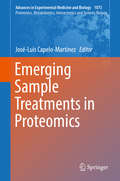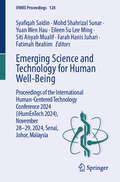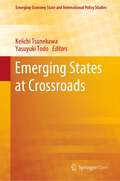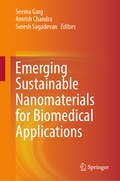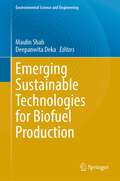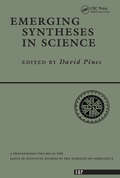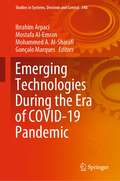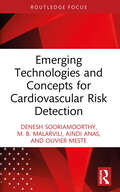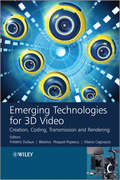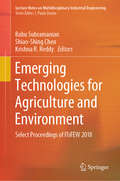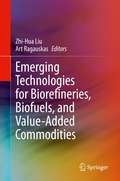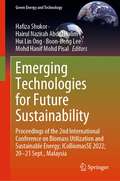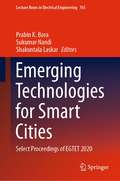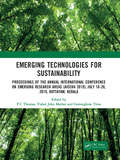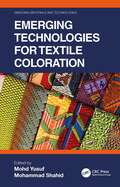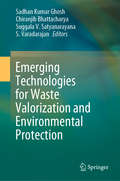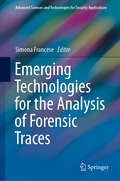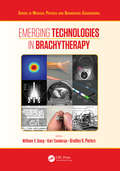- Table View
- List View
Emerging Sample Treatments in Proteomics (Advances in Experimental Medicine and Biology #1073)
by José-Luis Capelo-MartínezProteomics is a well-established area of Science; yet with a strong area in constant evolution, namely sample treatment. There few books that currently cover the field of emerging sample treatments in proteomics, this new volume will be the first to cover all emerging and existing studies. This unique book presents the latest advances in the field focusing on emerging trends linked to high-resolution mass spectrometry, technology addressed to treat samples faster and to attempts to simplify the proteome for the reader.
Emerging Science and Technology for Human Well-Being: Proceedings of the International Human-Centered Technology Conference 2024 (iHumEnTech 2024), November 28-29, 2024, Senai, Johor, Malaysia (IFMBE Proceedings #128)
by Fatimah Ibrahim Yuan Wen Hau Syafiqah Saidin Mohd Shahrizal Sunar Eileen Su Lee Ming Siti Aisyah Mualif Farah Hanis JuhariThis book covers advances in science and technologies promoting human health and/or enhancing everyday life. It discusses new methods to improve monitoring, therapy or rehabilitation, advances in telemedicine, machine learning applications in image processing, advanced materials for drug delivery, and a wide range of issues related to human-computer interaction, AI applications, sport technologies and technology safety. Based on the International Human-Centered Conference 2024 (iHumEnTech 2024), held on November 28 - 29, 2024, in Senai, Johor, Malaysia, this book offers a timely reference for both academics and professionals in the broad field of biomedical engineering, health technology and human-technology interaction.
Emerging States at Crossroads (Emerging-Economy State and International Policy Studies)
by Keiichi Tsunekawa Yasuyuki TodoThis book is open access under a CC BY-NC-ND license.This volume analyzes the economic, social, and political challenges that emerging states confront today. Notwithstanding the growing importance of the ‘emerging states’ in global affairs and governance, many problems requiring immediate solutions have emerged at home largely as a consequence of the rapid economic development and associated sociopolitical changes. The middle-income trap is a major economic challenge faced by emerging states. This volume regards interest coordination for technological upgrading as crucial to avoid the trap and examines how various emerging states are grappling with this challenge by fostering public-private cooperation, voluntary associations of market players, and/or social networks. Social disparity is another serious problem. It is deeply rooted in history in the emerging states such as South Africa and many Latin American countries. However, income distribution is recently deteriorating even in East Asia that was once praised for its high economic growth with equity. Increasing pressure for political opening is another challenge for emerging states. This volume argues that the economic, social, and political problems are interwoven in the sense that the emerging states need to build political consensus in order to tackle the economic and social difficulties. Democratic institutions have not always been successful in this respect.
Emerging Sustainable Aquaculture Innovations in Africa (Sustainability Sciences in Asia and Africa)
by Ndakalimwe Naftal Gabriel Edosa Omoregie Kenneth Prudence AbasubongThis edited book presents the emerging sustainable innovations in all areas of aquaculture in Africa with a view to create an opportunity whereby scientific outputs and recommendations can be endorsed for improved aquaculture outputs towards poverty alleviation and food security on the continent. Food insecurity and poverty are some of the challenges faced on the African continent. These challenges are further exacerbated by the growing human population and the impacts of climate change. Today, aquaculture has become one of the fastest food producing sectors in the world, with the potential to contribute significantly to food security and poverty alleviation in developing countries. In Africa, aquaculture is at an infant stage, however, many African countries have recognized the potential roles of aquaculture in food security, poverty alleviation and conservation of aquatic resources through their commitment to achieve the United Nation Sustainable Development Goals. The book reviews and synthesize research work from these thematic areas across Africa and provide a unique perspective on the emerging aquaculture innovations and illustrate how aquaculture practices could be feasible and cost effective while promoting social and environmental sustainability. The book also draws from global discussions on sustainable aquaculture practices and provides recommendations on what is feasible for Africa. This book is a great tool for the university students, scholars, aquaculture farmers, investors, and policymakers to understand the scientific based sustainable aquaculture innovations from an African perspective. This book is focused on SDG 2 and SDG 14.
Emerging Sustainable Nanomaterials for Biomedical Applications
by Seema Garg Amrish Chandra Suresh SagadevanThis book comprises a detailed overview of nanomaterials for biomedical applications and public health. Nanomaterials show various functions in medicine, sunscreens, electronic device, diagnostics, military applications, photovoltaic cells, paints, imaging, catalysts and drug delivery. In this book carbon Nanotubes/nanowires/nanofibers are explored for tissue engineering applications. Functionalized carbon nanotubes, silica Nanoparticle, silicon quantum dots, metal Decorated Nanomaterials, biogenic metal nanoparticles, magnetic functionalized nanomaterials and nanozymes have been covered for the treatment of bacterial Infections as carriers of gene delivery and for their biological applications. This book also explores nano-biotechnology and its approach for a sustainable future.
Emerging Sustainable Technologies for Biofuel Production (Environmental Science and Engineering)
by Maulin Shah Deepanwita DekaThis book is presented on biofuel production which includes different technologies developed and adopted to synthesize green renewable fuel alternatives for sustainable development. It also reflects different sources of biofuel, application of microbial community and microbial engineering to design fuel production and the biosynthetic pathways of biofuel production by microbes.Although the expenses for the physical and chemical technologies for energy production and fossil fuel utilization to protect our environment are very high, these technologies are not eco-friendly and safe. Hence, the need of certain modern eco-friendly and cost-effective techniques to protect our environment is deeply apprehended by different workers of this field. These techniques involve some feasible technologies utilizing different biological agents like microbes to produce renewable energy. This book provides an outline of the science behind the multidisciplinary aspects of biofuel production. It summarizes a solid foundation in the fundamentals and progresses to practical applications in this field. It structures stepwise route for a number of effective techniques to screen, select, identify and utilize microbes for biofuel production and utilization. It also focuses on the theoretical groundworks of biofuel production, recent technologies related to microbial engineering like myco-engineering technologies, microbial metabolism or modelling approaches to microbial physiology utilized for the same purpose. The techniques covered in this book ensure that scientists have the knowledge to practice effective biofuel production techniques themselves in a contaminated ecosystem in a sustainable way.Recent progress in the field of biofuels using microbial genetic engineering has larger perspectives in commercial-scale production. However, its large-scale production is still challenging; hence, to resolve this problem, it is essential to convert biomass into biofuels by developing novel technology to increase biofuel production to fulfil the current and future energy demand.
Emerging Syntheses In Science
by David PinesThe Santa Fe Institute, as key element in its founding activities, sponsored two workshops on 'Emerging Syntheses in Science.' There was unanimous agreement among the participants that Professor Gell-Mann's keynote address and the ensuing talks were of such high quality and general interest that it would be highly desirable to publish these for broader distribution.
Emerging Technologies During the Era of COVID-19 Pandemic (Studies in Systems, Decision and Control #348)
by Mostafa Al-Emran Gonçalo Marques Ibrahim Arpaci Mohammed A. Al-SharafiThis book tackles the recent research directions in using the newly emerged technologies during the era of COVID-19 pandemic. It mainly focuses on using emerging technologies and their impact on health care, education, and society. It also provides insights into the current challenges and constraints in using technologies during the era of COVID-19 pandemic and exposes new opportunities for future research in the domain.
Emerging Technologies In Sustainable Innovation, Management and Development
by R. UdayakumarICETSIMD 2025 was conceived as a vital platform for academicians, researchers, and industry leaders. Its primary purpose was to explore the transformative potential of emerging technologies in driving sustainable development. To ensure the high quality, originality, and relevance of the contributions, all submissions to the ICETSIMD 2025 confer□ence underwent a rigorous double-blind peer review process.We received 300 manuscript submissions, from which 100 were selected for inclusion in the conference proceedings. Each manuscript was evaluated by at least two independent experts based on criteria including scientific rigor, methodological soundness, clarity, and contribution to the conference themes.
Emerging Technologies and Concepts for Cardiovascular Risk Detection
by Denesh Sooriamoorthy M. B. Malarvili Aindi Anas Olivier MesteThis accessible guide to advanced medical technologies and methodologies for monitoring, diagnosing, and predicting cardiovascular diseases addresses sensor technologies and non-invasive monitoring methods and looks at the growing integration of machine learning and AI.The authors guide readers from an introduction to the cardiovascular system and a review of traditional and modern diagnostic methods before explaining recent advances in medical technology, such as wearable smart devices and their sensor types (namely, pressure, photoelectric, and ultrasonic), and how these advances have been applied to cardiovascular disease diagnosis and detection. Key topics include pulse wave analysis, sensor technology for radial blood pressure monitoring, and the integration of artificial intelligence to enhance predictive accuracy. With a focus on continuous monitoring solutions, this book highlights groundbreaking research on non-invasive detection methods and the development of intelligent health systems for real-time patient evaluation. The authors also discuss how the widespread implementation of machine learning and deep learning techniques have influenced the field and propose new methods for enhancing continuous monitoring and risk prediction systems. The information within this book will help to bridge the gap between research and clinical practice.This short guide is a valuable resource primarily for academic readers in the fields of biomedical engineering, physics, computer science, and medical imaging. Clinicians will also benefit from the discussions of applications and future research and clinical trends.
Emerging Technologies for 3D Video: Creation, Coding, Transmission and Rendering
by Marco Cagnazzo Frederic Dufaux Béatrice Pesquet-PopescuWith the expectation of greatly enhanced user experience, 3D video is widely perceived as the next major advancement in video technology. In order to fulfil the expectation of enhanced user experience, 3D video calls for new technologies addressing efficient content creation, representation/coding, transmission and display. Emerging Technologies for 3D Video will deal with all aspects involved in 3D video systems and services, including content acquisition and creation, data representation and coding, transmission, view synthesis, rendering, display technologies, human perception of depth and quality assessment. Key features: Offers an overview of key existing technologies for 3D video Provides a discussion of advanced research topics and future technologies Reviews relevant standardization efforts Addresses applications and implementation issues Includes contributions from leading researchers The book is a comprehensive guide to 3D video systems and services suitable for all those involved in this field, including engineers, practitioners, researchers as well as professors, graduate and undergraduate students, and managers making technological decisions about 3D video.
Emerging Technologies for Agriculture and Environment: Select Proceedings of ITsFEW 2018 (Lecture Notes on Multidisciplinary Industrial Engineering)
by Krishna R. Reddy Babu Subramanian Shiao-Shing ChenThis book comprises select proceedings of the International Conference on Emerging Technologies for Farming – Energy & Environment – Water (ITsFEW 2018). The contents are divided into three parts viz., (i) Developments in Farming, (ii) Energy and Environment, and (iii) Water Conservation and Management. The book aims to provide timely solutions, using innovative and emerging technologies, to the global challenges in agriculture, energy, environment, and water management. Some of the topics covered in this book include remote sensing for smart farming, GIS, irrigation engineering, soil science and agronomy, smart grids, renewable energy, energy management systems, energy storage technologies, biological water treatment, industrial waste water treatment, watershed management and sustainability. Given the wide range of topics discussed, the book will be very useful for students, researchers and practitioners interested in agricultural and environmental engineering.
Emerging Technologies for Biorefineries, Biofuels, and Value-Added Commodities
by Zhi-Hua Liu Art RagauskasThis book provides in-depth coverage on the latest concepts, systems, and technologies that are being utilized in biorefineries for the production of biofuels and value-added commodities. Written by internationally recognized experts, the book provides a comprehensive overview of pretreatment technology for biorefineries and biofuels, enzymatic hydrolysis and fermentation technology for biofuel production, and lignin valorization for developing new products from waste lignin. The book will be a valuable resource for researchers and professionals working in process engineering, product engineering, material science, and systems and synthetic biology in the fields of biorefining, biofuel, biomaterials, environmental waste utilization, and biotechnology.
Emerging Technologies for Economic Development (Science, Technology and Innovation Studies)
by Leonid Gokhberg Dirk Meissner Ozcan SaritasThis book provides an impressive overview of emerging technologies, especially nanotechnologies and biotechnologies, and their prospective applications. It identifies and describes existing and potential markets for emerging technology-based applications, and projects scenarios for macroeconomic development based on these technologies. Integrated roadmaps for the development of a nano- and bioindustry are shown and policy measures and corporate strategies developed to advance these technologies. These measures are illustrated using roadmaps and policy case studies.The book combines a practical, comprehensive overview of the technical side of emerging technologies and their applications in various fields with an analysis of market developments and characteristics.
Emerging Technologies for Future Sustainability: Proceedings of the 2nd International Conference on Biomass Utilization and Sustainable Energy; ICoBiomasSE 2022; 20–21 Sept., Malaysia (Green Energy and Technology)
by Hafiza Shukor Hui Lin Ong Hairul Nazirah Abdul Halim Boon-Beng Lee Mohd Hanif Mohd PisalThis book presents high-quality peer-reviewed articles from the 2nd International Conference on Biomass Utilization and Sustainable Energy 2022 (ICoBiomasSE 2022) organized by the Centre of Excellence for Biomass Utilization (COEBU), Universiti Malaysia Perlis (UniMAP), Malaysia. The theme of the conference “Emerging Technology for Future Sustainability” is chosen in view of the current revolution and rapid developments in the field of biomass innovation towards sustainable development. The contents are broadly divided into five parts: (1) sustainable biomass resources for decarbonizing the economy, (2) biomass conversion technologies for bioenergy and biofuels, (3) biomass conversion to intermediates and products, (4) bioeconomy sustainability, impacts and policies and (5) bioenergy integration. It provides a platform for students, professionals, researchers, academicians, policymakers and industries working in the areas of biomass utilization and sustainable energy to solve long-standing environmental issues for a healthier planet.
Emerging Technologies for STEAM Education
by Dirk Ifenthaler J. Michael Spector Xun GeThis theory-to-practice guide offers leading-edge ideas for wide-scale curriculum reform in sciences, technology, engineering, the arts, and mathematics--the STEAM subjects. Chapters emphasize the critical importance of current and emerging digital technologies in bringing STEM education up to speed and implementing changes to curricula at the classroom level. Of particular interest are the diverse ways of integrating the liberal arts into STEM course content in mutually reshaping humanities education and scientific education. This framework and its many instructive examples are geared to ensure that both educators and students can become innovative thinkers and effective problem-solvers in a knowledge-based society. Included in the coverage: Reconceptualizing a college science learning experience in the new digital era. Using mobile devices to support formal, informal, and semi-formal learning. Change of attitudes, self-concept, and team dynamics in engineering education. The language arts as foundational for science, technology, engineering, art, and mathematics. Can K-12 math teachers train students to make valid logical reasoning? Moving forward with STEAM education research. Emerging Technologies for STEAM Education equips educators, education researchers, administrators, and education policymakers with curricular and pedagogical strategies for making STEAM education the bedrock of accessible, relevant learning in keeping with today's digital advances.
Emerging Technologies for Smart Cities: Select Proceedings of EGTET 2020 (Lecture Notes in Electrical Engineering #765)
by Sukumar Nandi Prabin K. Bora Shakuntala LaskarThis book comprises the select proceedings of the International Conference on Emerging Global Trends in Engineering and Technology (EGTET 2020), held in Guwahati, India. The chapters in this book focus on the latest cleaner, greener, and efficient technologies being developed for the implementation of smart cities across the world. The broader topical sections include Smart Buildings, Infrastructures and Disaster Management; Smart Governance; Technologies for Smart Cities, and Wireless Connectivity for Smart Cities. This book will cater to students, researchers, industry professionals, and policy making bodies interested and involved in the planning and implementation of smart city projects.
Emerging Technologies for Smart Cities: Sustainable Transport Planning in the Global North and Global South
by Samson Olawale Fadare Trynos Gumbo Oluwayemi-Oniya AderibigbeThis book examines the use of smart city-associated technologies to enhance sustainable transportation planning in cities of both the global north and south, focusing specifically on sustainable transportation. The authors of the book examine technologies and tools such as UAVs, GIS, cutting-edge information and communication technologies, machine learning and big data to assess their potential for reducing traffic, redirecting traffic to assigned routes, monitoring traffic growth and development in our urban centres, with the ultimate aim of reducing congestion/commuting time, accidents, and pollution to promote climate action and a just transition. The book offers a comparative study of transport situation and planning in the developed and developing countries, focusing on the United States of America, Germany and Singapore in the Global North on one hand and South Africa, Nigeria and India from the Global South on the other. As more and more of the world’s population lives in urban centers, proactively monitoring and managing car traffic is essential. The book will be of interest to academics and researchers in the built environment (architecture, urban and regional planning, construction management, quantity surveying, geography), engineering, environmental sciences, social sciences, public policy, design in both the developed and developing countries.
Emerging Technologies for Sustainability: Proceedings of the Annual International Conference on Emerging Research Areas (AICERA 2019), July 18-20, 2019, Kottayam, Kerala
by P. C. Thomas; Vishal John Mathai; Geevarghese TitusThe theme of conference is Emerging Technologies for Sustainability. Sustainability tends to be problem driven and oriented towards guiding decision making. The goal is to raise the global standard of living without increasing the use of resources beyond global sustainable levels. The conference is intended to act as a platform for researchers to share and gain knowledge, showcase their research findings and propose new solutions in policy formulation, design, processing and application of green materials, material selection, analysis, green manufacturing, testing and synthesis, thereby contributing to the creation of a more sustainable world.
Emerging Technologies for Textile Coloration (Emerging Materials and Technologies)
by Mohd YusufThis book features perspectives on advances in textile coloration technologies. It provides a comprehensive and holistic overview, supporting rapid and efficient entry of new researchers into emerging subjects within textile engineering and technology. FEATURES Introduces current, reliable coloration technologies Explains emerging coloration technologies from a multidisciplinary point of view Discusses future R&D opportunities Offers systematic, research-oriented outlines and observations and well-defined illustrative models and schemes Written for academicians, scientists, researchers, and advanced students of textile science and technology, Emerging Technologies for Textile Coloration aims to provide depth of understanding of both state-of-the-art and emergent topics and to spur further research leading to new opportunities and applications.
Emerging Technologies for Waste Valorization and Environmental Protection
by Sadhan Kumar Ghosh Chiranjib Bhattacharya Suggala V. Satyanarayana S. VaradarajanThis book features carefully selected articles on emerging technologies for waste valorization and environmental protection. The term “waste valorization” is used particularly in engineering, economics, technology, business, environmental and policy literature to refer to any unit operation or collection of operations targeted at reusing, recycling, composting or converting wastes into useful products or energy sources without harming the environment. The book discusses the rudimentary concept, and describes a range of emerging technologies in the field, including nano, fuel-cell and membrane technologies, as well as membrane bioreactors. It also examines in detail essential and common processes in waste valorization, such as rigorous chemical engineering applications, mathematical modeling and other trans-disciplinary approaches. The chapters present high-quality research papers from the IconSWM 2018 conference.
Emerging Technologies for the Analysis of Forensic Traces (Advanced Sciences and Technologies for Security Applications)
by Simona FranceseThis book provides a line of communication between academia and end users/practitioners to advance forensic science and boost its contribution to criminal investigations and court cases. By covering the state of the art of promising technologies for the analysis of trace evidence using a controlled vocabulary, this book targets the forensics community as well as, crucially, informing the end users on novel and potential forensic opportunities for the fight against crime. By reporting end users commentaries at the end of each chapter, the relevant academic community is provided with clear indications on where to direct further technological developments in order to meet the law requirements for operational deployment, as well as the specific needs of the end users. Promising chemistry based technologies and analytical techniques as well as techniques that have already shown to various degrees an operational character are covered. The majority of the techniques covered have imaging capabilities, that is the ability to visualize the distribution of the target molecules within the trace evidence recovered. This feature enhances intelligibility of the information making it also accessible to a lay audience such as that typically found with a court jury. Trace evidence discussed in this book include fingermarks, bodily fluids, hair, gunshot residues, soil, ink and questioned documents thus covering a wide range of possible evidence recovered at crime scenes.
Emerging Technologies in Biological and Hybrid Wastewater Treatment: Lessons from Developed to Enhancing Practices in Developing Countries (Earth and Environmental Sciences Library)
by Shalini Yadav Ram Narayan Yadava Makarand M. GhangrekarThis book provides technical information on different biological and hybrid wastewater treatment systems for treatment of wastewater and reuse. The contained information helps in tracking their progress of such systems toward practical and field-scale applications. The book also includes strategies to be adopted for minimizing the losses and maximizing the benefits. Additionally, it includes methods for protecting the environment through the application of advanced biological and hybrid wastewater treatment technology. Furthermore, it discusses the crucial parts that science, technology, and innovation play in the formulation, implementation, and administration of wastewater treatment policy. It highlights the challenges that must be overcome to adopt biological and hybrid wastewater treatment infrastructure regulations successfully and provides some answers. It investigates how the biological and hybrid wastewater treatment technology may be used in a wide variety of field's sets apart from other on-the-shelf publications on the market. Also, it delves into the core concepts of biological and hybrid wastewater treatment systems. It explores how these concepts can be modified to fit a variety of contexts and uses. Applications such as managing facilities, dealing with pandemics, urban wastewater treatment and reuse, farming, and other applications are included in this book. This book is helpful to researchers, entrepreneurs, professionals, planners, policymakers, environmental engineers, and others interested in biological and hybrid wastewater treatment system management strategies through the application of breakthroughs in biological and hybrid wastewater treatment technologies. Also, it is useful as a fundamental source of information and state-of-the-art knowledge to graduate students, university faculties, and researchers in the fields of environmental sciences/engineering, biological and chemical sciences, and NGO. It is also useful to entrepreneurs, professionals, and planners in policy and decision making at the local, state, and national levels for many countries.
Emerging Technologies in Biomedical Engineering and Sustainable TeleMedicine (Advances in Science, Technology & Innovation)
by Somaya Al-Maadeed Jihad Alja’am Osama HalabiThis book presents the most recent research and applications in Biomedical Engineering, electronic health and TeleMedicine. Top-scholars and research leaders in the field contributed to the book. It covers a broad range of applications including smart platforms like DietHub which connects patients with doctors online. The book highlights the advantages of Telemedicine to improve the healthcare services and how it can contribute to the homogenization of medicine without any geographical barriers. Telemedicine transforms local hospitals, with limited services, into a node of an integrated network. In this manner, these nodes start to play an important role in preventive medicine and in high-level management of chronic diseases. The authors also discuss the challenges related to “health informatics” and in “e-health management”. The topics of the book include: synchronous and asynchronous telemedicine with deep discussions on e-health applications, virtual medical assistance, real-time virtual visits, digital telepathology, home health monitoring, and medication adherence, wearable sensors, tele-monitoring hubs and sensors, Internet of Things, augmented and virtual reality as well as e-learning technologies. The scope of the book is quite unique particularly in terms of the application domains that it targets. It is a unique hub for the dissemination of state of the art research in the telemedicine field and healthcare ecosystems. The book is a reference for graduate students, doctors, and researchers to discover the most recent findings, and hence, it achieves breakthroughs and pushes the boundaries in the related fields.
Emerging Technologies in Brachytherapy (Series in Medical Physics and Biomedical Engineering)
by William Y. Song Kari Tanderup Bradley PietersBrachytherapy is continuously advancing. Years of accumulated experience have led to clinical evidence of its benefit in numerous clinical sites such as gynecological, prostate, breast, rectum, ocular, and many other cancers. Brachytherapy continues to expand in its scope of practice and complexity, driven by strong academic and commercial research, by advances in competing modalities, and due to the diversity in the political and economic landscape. It is a true challenge for practicing professionals and students to readily grasp the overarching trends of the field, especially of those technologies and innovative practices that are not yet established but are certainly on the rise. Addressing this challenge, Emerging Technologies in Brachytherapy presents a comprehensive collection of chapters on the latest trending/emerging technologies and expert opinions. It is divided into five broad sections: Section I: Physics of Brachytherapy Section II: Imaging for Brachytherapy Guidance Section III: Brachytherapy Suites Section IV: Is Brachytherapy a Competitive Modality? Section V: Vision 20/20: Industry Perspective Each section has a carefully selected collection of chapters, which covers the spectrum of topics in comprehensive detail. By drawing on recognized experts and key opinion leaders from academia and commercial sectors worldwide (100+ contributors), Emerging Technologies in Brachytherapy provides readers with a wealth of relevant information needed to comprehend the rapidly advancing technologies and trends of today and the prospects for the future.
